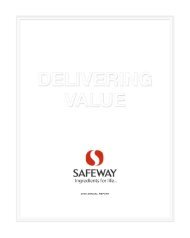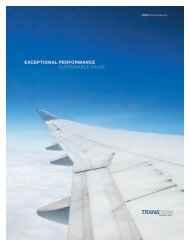Bemis Company 2007 Annual Report - IR Solutions
Bemis Company 2007 Annual Report - IR Solutions
Bemis Company 2007 Annual Report - IR Solutions
You also want an ePaper? Increase the reach of your titles
YUMPU automatically turns print PDFs into web optimized ePapers that Google loves.
NOTES TO CONSOLIDATED FINANCIAL STATEMENTS<br />
Note 1 – BUSINESS DESCRIPTION AND SIGNIFICANT ACCOUNTING POLICIES<br />
Description of the business: <strong>Bemis</strong> <strong>Company</strong>, Inc., a Missouri corporation, was founded in 1858 and incorporated in 1885 as <strong>Bemis</strong> Bro.<br />
Bag <strong>Company</strong>. In 1965 the name was changed to <strong>Bemis</strong> <strong>Company</strong>, Inc. (the <strong>Company</strong>). Based in Neenah, Wisconsin, the <strong>Company</strong><br />
employs approximately 15,700 individuals and has 56 manufacturing facilities located in the United States and ten other countries around<br />
the world. The <strong>Company</strong> is a manufacturer of flexible packaging products and pressure sensitive materials selling to customers<br />
throughout the Americas and Europe, with a growing presence in Asia Pacific.<br />
The <strong>Company</strong>’s business activities are organized around its two business segments, Flexible Packaging, which accounted for<br />
approximately 82 percent of <strong>2007</strong> net sales, and Pressure Sensitive Materials, which accounted for the remaining net sales. The<br />
<strong>Company</strong>’s flexible packaging business has a strong technical base in polymer chemistry, film extrusion, coating, laminating, printing,<br />
and converting. The <strong>Company</strong>’s pressure sensitive materials business specializes in adhesive technologies. The primary markets for the<br />
<strong>Company</strong>’s products are in the food industry, which accounted for approximately 60 percent of <strong>2007</strong> net sales. The <strong>Company</strong>’s flexible<br />
packaging products are widely diversified among food categories and can be found in nearly every aisle of the grocery store. Other<br />
markets include chemical, agribusiness, medical, pharmaceutical, personal care products, electronics, automotive, construction, graphic<br />
industries, and other consumer goods. All markets are considered to be highly competitive as to price, innovation, quality, and service.<br />
Principles of consolidation: The consolidated financial statements include the accounts of the <strong>Company</strong> and its majority owned<br />
subsidiaries. All intercompany transactions and accounts have been eliminated. Joint ventures which are not majority controlled are<br />
accounted for by the equity method of accounting with earnings of $933,000 and $32,000 in <strong>2007</strong> and 2006, respectively, included in<br />
other costs (income), net, on the accompanying consolidated statement of income. Investments in joint ventures are included in deferred<br />
charges and other assets on the accompanying consolidated balance sheet.<br />
Estimates and assumptions required: The preparation of financial statements in conformity with accounting principles generally<br />
accepted in the United States of America requires management to make estimates and assumptions that affect the reported amounts of<br />
assets and liabilities at the date of the financial statements and the reported amounts of revenues and expenses during the reporting period.<br />
Actual results could differ from those estimates.<br />
Translation of foreign currencies: The <strong>Company</strong> considers the local currency to be the reporting currency for all foreign subsidiaries.<br />
Assets and liabilities are translated at the exchange rate as of the balance sheet date. All revenue and expense accounts are translated at<br />
average exchange rates in effect during the year. Translation gains or losses are recorded in the foreign currency translation component in<br />
accumulated other comprehensive income (loss) in stockholders’ equity. Foreign currency transaction gains (losses) of $2,445,000,<br />
$(849,000), and $(5,434,000), in <strong>2007</strong>, 2006, and 2005, respectively, are included as a component of other costs (income), net.<br />
Revenue recognition: Sales and related costs of sales are recognized upon shipment of products or when all of the conditions of the<br />
Securities and Exchange Commission’s Staff Accounting Bulletin No. 104 are fulfilled. All costs associated with revenue, including<br />
customer volume discounts, are recognized at the time of sale. Customer volume discounts are accrued in accordance with EITF No. 01-<br />
9, Accounting for Consideration Given by a Vendor to a Customer and recorded as a reduction to sales. Shipping and handling costs are<br />
classified as a component of costs of sales while amounts billed to customers for shipping and handling are classified as a component of<br />
sales. The <strong>Company</strong> accrues for estimated warranty costs when specific issues are identified and the amounts are determinable.<br />
Environmental cost: The <strong>Company</strong> is involved in a number of environmental related disputes and claims. The <strong>Company</strong> accrues<br />
environmental costs when it is probable that these costs will be incurred and can be reasonably estimated. At December 31, <strong>2007</strong> and<br />
2006, reserves were $588,000 and $830,500, respectively. Adjustments to the reserve accounts and costs which were directly expensed<br />
for environmental remediation matters resulted in charges to the income statements for <strong>2007</strong>, 2006, and 2005 of $111,000, $128,000, and<br />
$14,000, net of third party reimbursements totaling $0, $102,000, and $11,000, for <strong>2007</strong>, 2006, and 2005, respectively.<br />
Earnings per share: Basic earnings per common share is computed by dividing net income by the weighted-average number of common<br />
shares outstanding during the year. Diluted earnings per share is computed by dividing net income by the weighted-average number of<br />
common shares outstanding during the year and dilutive shares relating to stock incentive plans. The following table presents information<br />
necessary to compute basic and diluted earnings per common share:<br />
(in thousands, except per share amounts) <strong>2007</strong> 2006 2005<br />
Weighted average common shares outstanding – basic……………. 102,992 104,865 106,433<br />
Dilutive shares…………………………………………... 1,122 1,902 1,386<br />
Weighted average common and common<br />
equivalent shares outstanding – diluted………………………... 104,114 106,767 107,819<br />
Net income for basic and diluted earnings<br />
per share computation…………………………………............. $181,554 $176,296 $162,529<br />
Earnings per common share – basic………………………………. $1.76 $1.68 $1.53<br />
Earnings per common share – diluted…………………………….. $1.74 $1.65 $1.51<br />
Certain options outstanding at December 31, 2005 (2,494 shares) were not included in the computation of diluted earnings per<br />
share above because they would not have had a dilutive effect.<br />
Research and development: Research and development expenditures are expensed as incurred.<br />
24







